Scott Holiday – The Fuzz Lord Enters the Halls of Helix
by James Rotondi
When fans of the explosive American classic rock quartet Rival Sons dubbed guitarist Scott Holiday “Fuzz Lord,” it was on account of his penchant for scorching old-school analog fuzz circuits in the tradition of the Sola Sound Tone Bender, the Roger Mayer Octavia, and others. But while Holiday has made boutique octave-fuzz and other polyphonic flavors his signature sound for the last decade on Sons’ albums like 2011’s Pressure & Time, 2014’s Great Western Valkyrie, and 2019’s Feral Roots, he’s equally at home with rack gear, MIDI controllers, and yes, amp and effects modelers.
Indeed, as he explains here during a break from sessions at Nashville’s legendary RCA Studio A for the follow-up to Feral Roots, Holiday has a long history with Line 6 gear, making his more recent jump into the Helix universe a smooth and seamless quantum shift, a new paradigm into which he’s deftly woven his analog soul (and a small clutch of those great boutique pedals) into the digital realm, creating a Helix Floor-based “B Rig” as a downsized, but very powerful fly rig alternative to his copious cornucopia of heavy Orange and Supro amp heads and his fleet of badass boutique stomps. “All the band and crew fell in love with the Helix,” Holiday laughs. “They said, ‘How much are we saving by not taking your monstrosity of an A-Rig? Take the damn Helix!’”
You’re strongly identified with vintage fuzz pedal tones. So, some folks may be surprised to learn that you have a long history with Line 6 gear.
Yeah, I’m known for being pretty purist about tone, but even before Rival Sons, I had one of the kidney bean-shaped red PODs. I’m from Huntington Beach, CA, the town where Korn is from, and I knew those fellas from around town. And I distinctly remember Munky telling me, “Oh, dude, you’ve got to check out this little kidney-bean thing from a company called Line 6 called the POD.” He helped connect me with the company, and so I got a POD really early on, and loved it. In fact, at some point I sold my entire traditional guitar rig and got that first head that they built, the 300-watt Flextone II, with the foot-switchable board that went with it. So, yeah, I was an early advocate of modeling.
And I’ve always kept a Line 6 DL4 Delay Modeler in my rig; it’s still on my main effects board to this day after more than 20 years, and it has never busted on me. I even used the Line 6 Echo Pro rack delay module in my first big Bradshaw rack system. Great delay—they should bring that one back!
Still, old school fuzz tones and big ol’ heads have been the basis of your sound for a while. How did Helix find its way into your gear manifest?
In the last couple of years, I had to build a really dependable and easy-to-transport fly rig for Rival Sons. For many shows, especially internationally, it just wasn’t logistically possible or cost-effective to bring my entire A Rig—all those massive heads, all those pedalboards, and the rack stuff, too. And that’s where the Helix came in for me. I spoke to my buddy Scott Marceau at Line 6, and he told me how great it was, and explained that Billy and Jeff from Smashing Pumpkins were really deep into it. So, while I may seem like the guy who would fight digital effects technology, it’s just not the case. In fact, I love the challenge of trying to recreate my analog tones in this very digital world. So, I thought, “Let’s see if we can do it!”
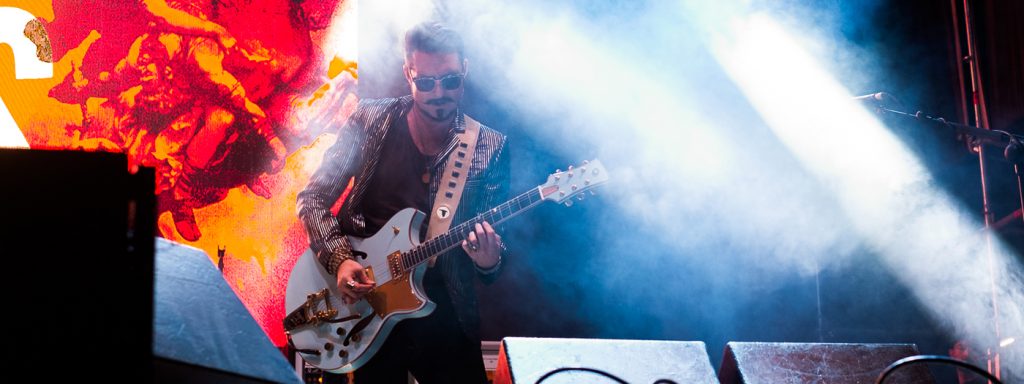
And how did you find working with Helix at first?
I just immediately took to it. I’d had some experience using HX Effects for certain things in my A Rig, and maybe due to my years of using MIDI and rack gear, I felt I just understood the workflow from the start. The Helix interface is so money, it’s so friendly and easy to navigate, and there lots of real knobs to grab. I found it super-intuitive—friendly and deep at the same time. Still, the first thing I did after getting my bearings with Helix was to recognize that there were certain boutique pedal sounds I used, especially polyphonic sounds like octavers, synth pedals, and octave fuzzes, that were just really identifiable as Rival Sons sounds, and that while Helix had those types of effects, my key fuzzes and octave effects were pedals that needed to be present in the chain to really deliver my signature sounds.
Of course, this is exactly why Line 6 included four sends on Helix. They did that for a reason! So, I use all the sends in Helix for four of my own key pedals. The Roger Mayer Octavia is in there. I’ve got a Hell Bender by Deep Trip (kinda their take on a Tone Bender), the Electro-Harmonix POG, and the Electro-Harmonix Bass Micro-Synth. I figured out that with these couple fuzzes, and those two octave effects, plus the great internal effects, amps and cabs in the Helix, I could get all the sounds I absolutely needed when I wasn’t able to bring my big A Rig.
Talk to me a little about how you replicate your live backline using Helix so convincingly; I’ve heard both setups and honestly, I can’t tell the difference.
Sure. So, I use the Helix Floor in stereo, true, but I look at it more like “Signal Path 1” and “Signal Path 2,” because live I use a combination of Orange CS-50s, which are typically the “right” or “Signal Path 1” side of that stereo pair, along with Supro Statesman heads, which are usually the “left” or “Studio Path 2” of the stereo path. So, my first job was to find amps in Helix that I thought got into that world and sounded pretty damn close. And I did. But there was plenty of fine-tuning to be done to really dial it in. So, one day we were playing in Denver, and during our day off before the show, the theater allowed us to load in early and get set up.
Now, I travel with enough backup cabs that I could pretty easily set up both the A Rig and the B Rig in their entirety: cabs with the Orange and Supro heads for the outboard A Rig pedals going through them, side-by-side with cabinets that were connected to the mainly Helix-based B Rig setup with those four pedals looped in and a dedicated power amp. And an A/B switch in between. So, we spent a whole day matching the tones. I would yell out to our FOH guy, “Here’s the Orange clean! And now here’s the Helix approximating the Orange clean!” And he would say through the monitors, “Hmm—more top end! No, more bottom-end! Less bottom-end!” And we just got really meticulous about it until it matched perfectly.
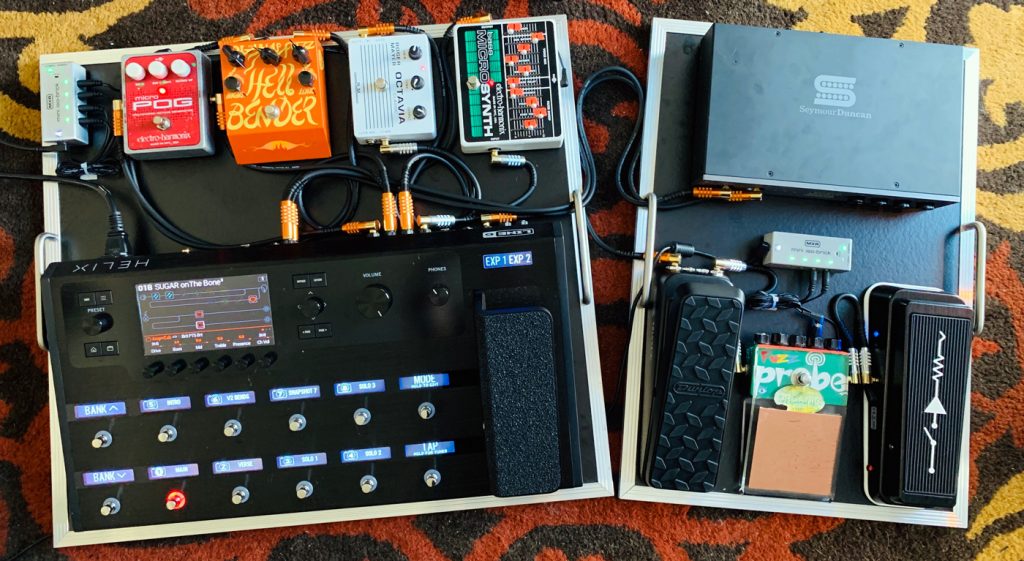
And presumably you focused on the raw amp sounds first before moving on to the effects?
Totally. I focused first on the sounds of the real amps raw, no effects: the main Orange clean channel, then the main Orange dirty channel sound. The Supro clean tone, then the Supro dirty tone. And I created a master setting in Helix for all those key tones. Once I had those, I just treated the Helix like my normal live rig. These are the amps I use, so let’s put those both on every single preset. Then it was a matter of dialing in the effect chains. Where is this fuzz or octave pedal set and positioned in the A Rig? Let’s do that on the Helix B Rig. The next step was to use the Helix’s internal modulations, delays, and reverbs to craft all the time-domain stuff as close as possible to what’s on the records and on my pedalboards, which is a mixture of Strymon TimeLine and Mobius, DL4, and some other pedals.
I also run a small input board just before the Helix, as well, with a tuner, wah pedal, a volume pedal, and the Z-Vex Fuzz Probe. That’s also where the Seymour Duncan Powerstage 700 power-amp lived for sending the Helix stereo-out to my cabinets onstage. Being the tone freakazoid that I am, after using the Duncan power-amp for a while, which sounds great, I recently decided that I wanted to run the Helix into a little two-space rack tube power amp, so I got the Mesa Boogie Stereo 2:Fifty, with 50 watts per side, and honestly, as good as those solid-state power amps are, the tube power amp does make a huge difference with Helix. It adds a lot of feel to that last stage of your Helix sound.
Can you share what specific Helix amp blocks and cabs you used to model your Orange and Supro heads?
Sure. I don’t actually use the Orange-style model that’s in there. For the Orange, I’m using the Solo Lead OD preamp, and for the Supro Statesman, I use the Cali 4 Rhythm 2. Now, I won’t use cabinet blocks with these if I’m playing live, because I go right into a power amp and off to whatever real cabs I have onstage—hopefully, actual Supro and Orange cabs if we can get them. But if I’m in a hotel room, for instance, I’ll use the 2×12 Silver Bell cab block with the Supro-style model, and I use the 4×12 XXLV30 block with the Orange side of stuff. I should note that, unlike a lot of players, I don’t send the Helix direct to FOH ever. I just use it as a guitar pedal board and preamp, basically, and I let the tube power amp and the real cabs do their job. All the cabinets are still miked up as they would be normally. I think it keeps my sound as authentic as possible.
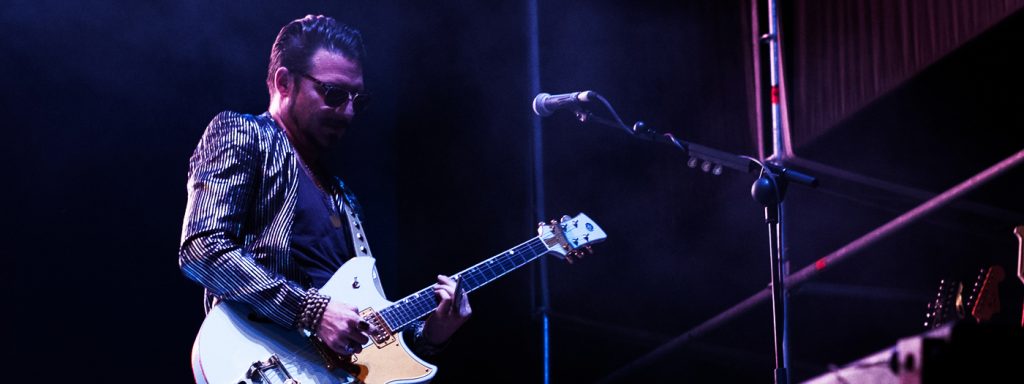
Putting aside the boutique pedals you loop into Helix, what are some of your go-to Helix effect blocks for delay, modulation and reverb?
For delays, I really like the Transistor Tape. That’s what I’m using mostly. I’ll also use the Legacy Plate Reverb a lot. I like the Ubiquitous Vibe modulation in there, which is based on a Shin-Ei Uni-Vibe. I use the Helix Floor expression pedal with that to adjust the depth and speed. In fact, I use the expression pedal on absolutely every song, for changing parameters like delay time and feedback. On “Too Bad,” I use the original Dual-Pitch block. I’ll definitely use the Kinky Boost, for a little extra oomph. I use the regular Modulation Tremolo quite a lot, too.
In my A rig, where I just have the HX Effects as a supportive processor, I use the Legacy Room Reverb a lot. I also use the Hard Gate a lot. It’s like my best friend, both with my B Rig and especially on the HX Effects with my A Rig, with all those noisy pedals going into it. When you’re using all sorts of heavy, gain-y fuzzes, and you want those really extreme sounds, especially in bigger rooms, you really want the space between your playing to be quiet. When you’re in between songs, that shit needs to be gone. So, I almost always have a Gate in my block path right before the delays and reverb, so that even though the main tone gets gated, it still has some breath because of the delay and reverb.
What other benefits have you gotten out of Helix that perhaps a conventional rig couldn’t give you? And what is it about your approach to Helix that you’d want people to take away from this interview?
Well, to have the extra bonus of Snapshots, and the titling of all these patches and presets is really great. I always use all eight Snapshots—that’s my look! I’ve got all my Snapshots titled according to every section of each song: Intro, Verse, Pre-Chorus, Chorus, Solo 1, Solo 2, etc. The ease of that kind of thing live, the way it frees you to focus on your playing and your performance, cannot be understated. It’s great. Helix is so deep that it would be easy to approach Helix with this idea that it should just replace all your other pedals. And y’know, it can do that. Sure. But Line 6 was smart enough to provide those four sends in Helix for a reason. So, you could make it your own. Yes, Helix has a great TS808-style block in it, but dude, if your favorite 30-year-old Tube Screamer is the cornerstone of your live sound, use it! Put it on a send. Or you may really like the Phasers they have in Helix, but if you’ve got this really cool Mu-Tron Bi-Phase, and you tell me that absolutely nothing else sounds like it? Well, gee, I dunno, you should probably use that!
More about Helix: https://line6.com/helix/index.html
Main Photo: David Poulain

Guitarist and writer James Rotondi has been a Senior Editor at Guitar Player and Guitar World, a contributor to Rolling Stone, JazzTimes, Acoustic Guitar, Mojo, and Spin, and has toured with the acclaimed bands Mr. Bungle, Humble Pie, and French electro-rock group Air. He lives in Nashville.
Related posts
Leave a Reply
You must be logged in to post a comment.
By submitting your details you are giving Yamaha Guitar Group informed consent to send you a video series on the Line 6 HX Stomp. We will only send you relevant information. We will never sell your information to any third parties. You can, of course, unsubscribe at any time. View our full privacy policy


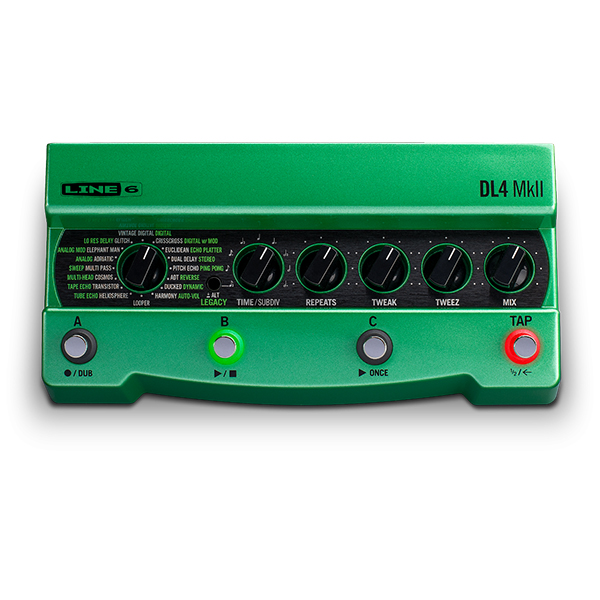
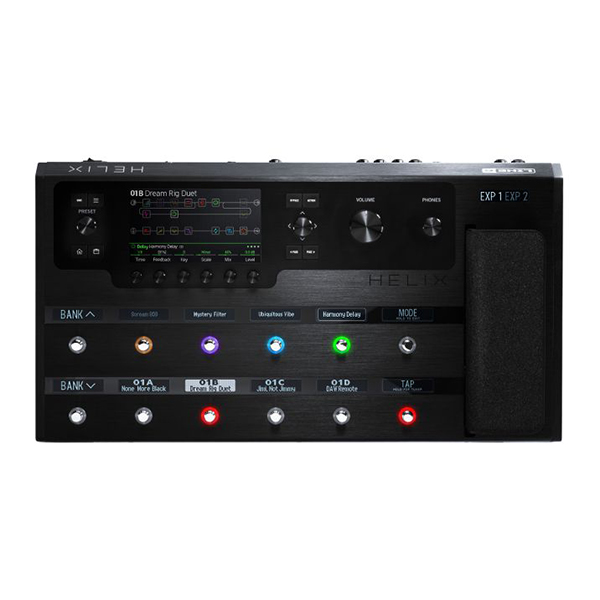


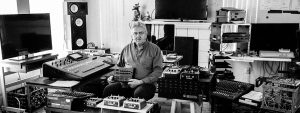
What an excellent article, love how deep he went into explaining how he got his sound and what he blocks he used! Can’t wait to fire up my HX and see what I can do with it!
Great article and a GREAT player with a GREAT live sound I can attest to being front and center of a Rival Sons show. And its obvious he knows his rig. Also some great shout-out to the legacy effects.
Hey guys, another great and interesting article! One friendly critique, these are very difficult to read on mobile phones due to being very tiny text. Is it possible to format in a way that it can scale for mobile? Anyway, please keep these coming – they are excellent and much appreciated.
I second @gyrfalcon, pinch zoom and swipe isn’t the most fun reading experience on mobile…